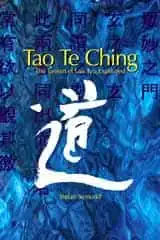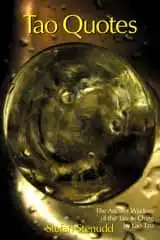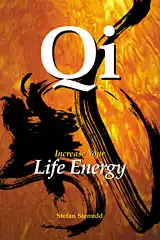|
Tao Te Ching
THE TAOISM OF LAO TZU
|
Tao Te Ching translationsA commented bibliographyHere is a list of books with translations of Tao Te Ching, used when examining fake Lao Tzu quotes, with my comments on each.
There's a forest of books about Taoism, Lao Tzu, and Tao Te Ching. It makes no sense to list them all, so I have chosen a few English versions of Tao Te Ching that I value or find significant in the continued exploration of Lao Tzu's thoughts. Less important works are also included if they have made an imprint in other literature or on the Internet. The subject is popular, so new books will appear as you read this, but I believe that some of the sources listed below will not that quickly be obsolete. Others, though, might be found less adequate and fade away. The books are listed alphabetically after the names of the persons writing the versions. I have added a short comment to every version listed, mainly regarding its content and style of translation.
As for the Taoism resources on the Internet, they change so quickly that I can only recommend a Google search (or whatever search engine is the most prominent one, when you read this). Notice that different spellings give partly different search results. For example, Tao Te Ching, Dao De Jing, and Daodejing searches may differ, although the major search engines now regard them as synonymous. The same is true for Lao Tzu, Lao Zi, and Laozi. Many complete translations of Tao Te Ching are available on the web.
Tao Te Ching VersionsAmes, Roger T. & Hall, David L.: DAO DE JINGNew York, Ballantine 2003. A knowledgeable and rather daring version, focusing on philosophical aspects, which also presents the text in Chinese. The 1993 findings in Guodian are richly presented and included in the interpretation. Balfour, Frederic Henry: TAOIST TEXTS London, Trubner & Co., 1884 This old version includes the Chinese text of Tao Te Ching and a translation that tends to be a bit over-explanatory, maybe also outdated, reminding of James Legge's version. The comments are knowledgeable. Blakney, Raymond B.: THE WAY OF LIFE USA, New American Library 1955. A straightforward and clear version of the text, but it often seems like paraphrasing, although he added what he called a "Paraphrase" version to each chapter. Neither version is near the standard translations. Bynner, Witter: THE WAY OF LIFE ACCORDING TO LAOTZU New York, Day 1944. An American version, which is also its subtitle. It is based on English versions of that time. In the effort to clarify the chapters, Bynner allowed himself to deviate quite far from Lao Tzu's text. Carus, Paul: LAO-TZE'S TAO-TEH-KING Chicago, Open Court Publishing 1898. This knowledgeable text presents Taoism and Lao Tzu, with a word by word translation of Tao Te Ching including the Chinese text, and his own version where Tao is translated as "Reason." That choice is possible, but rare. Chalmers, John: THE SPECULATIONS ON METAPHYSICS, POLITY, AND MORALITY OF "THE OLD PHILOSOPHER," LAU-TSZE London, Trübner 1868. This is the first translation into English of Tao Te Ching. The text is occasionally elaborate from striving to be true to the original, but by that it is also quite trustworthy. Chan, Wing-tsit: THE WAY OF LAO TZU Indianapolis, Bobbs-Merrrill 1963. The professor of Chinese culture and philosophy wrote a learned and trustworthy version, with each chapter richly commented. The book also contains bibliographies in Western and Eastern languages on the subject. Chen, Ellen M.: THE TAO TE CHING New York, Paragon 1989. With a knowledge that is only surpassed by the categorical attitude, Chen's version includes but is far from dominated by the Mawangdui manuscripts. Lots of facts are added, as well as far-reaching personal interpretations of Taoist philosophy and how to apply it. Cheng, Man-jan: LAO TZU: MY WORDS ARE VERY EASY TO UNDERSTAND California, North Atlantic Books 1981. Translated by Tam C. Gibbs. Cheng has commented the chapters of the text in short lessons, focused on the principles of Taoism. The explanations are so short that they don't add much to the text itself. The Chinese text is included in the book. Cleary, Thomas: THE ESSENTIAL TAO San Francisco, Harper Collins 1993. Cleary has translated several Taoist and Buddhist texts, which have been published in a number of different volumes. This one contains the texts of both Lao Tzu and Chuang Tzu. His translation is competent, although his choice of words is sometimes odd, deviating from the usual solutions. Crowley, Aleister: THE TAO TEH KING 1918. Several editions in print. The famous occultist made his own very personal interpretation of the text, where the hexagrams of I Ching have also been used. Crowley is always worth reading, although it's not certain that he speaks according to the Tao of Lao Tzu. Duyvendak, J. J. L.: TAO TE CHING London, Murray 1954. This professor of Chinese filled his version of the text with elaborate comments, including linguistic and philosophical aspects. Unfortunately, it is since long out of print. Feng, Gia-fu & English, Jane: LAO TSU: TAO TE CHING London, Wildwood 1972. This version is simple and rewarding, although it isn't always in accordance with prevalent opinion. It lacks commentaries, but is richly illustrated with both calligraphy of the chapters and mood-filled photographs. This book has since its release contributed greatly to the popularization of Tao Te Ching. A revised edition was published in 1989. Giles, Lionel: THE SAYINGS OF LAO TZU London, Orient Press 1904. In this translation the chapters have been completely reordered according to themes, not even stating what established chapters they belong to, which makes the book very hard to use as a reference. But both Lionel and his father Herbert were esteemed sinologists, translating several Chinese classics. Henricks, Robert G.: TE-TAO CHING New York, Ballantine 1989. The professor of religion manages a very trustworthy version of the text, based primarily on the manuscripts of Mawangdui. Because of their order of the chapters, he has reversed the words of the title. His comments are knowledgeable and precise. The Mawangdui texts in Chinese are also included. This is a major work on the Mawangdui findings. Henricks, Robert G.: LAO TZU'S TAO TE CHING New York, Columbia University Press 2000. In this book, Henricks concentrates on the findings in Guodian, which are competently presented and examined. They are also compared to the Mawangdui and Wang Pi versions. The texts are included in Chinese. The problem with the book is that the order of the chapters is according to the findings, which makes it difficult to use as a reference. Hoff, Benjamin: THE WAY TO LIFE: AT THE HEART OF THE TAO TE CHING Weatherhill 1981. This version makes some odd wording choices that are far from standard translations. The year after this book was published Hoff released The Tao of Pooh, which became an international bestseller and contributed to making Lao Tzu something of a household name. Ivanhoe, Philip J.: THE DAODEJING OF LAOZI New York, Seven Bridges Press 2002. The historian of Chinese thought has made a straightforward and clean translation of the text, a learned introduction to it, and comparisons between other translations. There are also many informative notes. Julien, Stanislas: LE LIVRE DE LA VOIE ET DE LA VERTU Paris 1842. Julien was a professor in Chinese at the Paris University. His French version is the first printed one in a Western language. It is still in print, as a facsimile. Unfortunately, there is no English translation of it. Karlgren, Bernhard: NOTES ON LAO-TSE Bulletin of Östasiatiska Museet, nr. 47/1975. Offprint. The prominent Swedish sinologist finally published, just three years before his demise, a version of the text. He did so in a way as modest as was his habit — in a magazine of the Stockholm East Asian Museum. His interpretation is precise and clarifying, but the comments are minimal. At the time of his interpretation, the findings in Mawangdui were not at his disposal. Karlgren, Bernhard: THE POETICAL PARTS OF LAO-TSI Göteborgs Högskolas årsskrift 1932:3 This essay goes through all the rhymes of Tao Te Ching in ancient or archaic Chinese. Lau, D.C.: LAO TZU: TAO TE CHING London, Penguin 1963. This professor of Chinese literature gave a knowledgeable and clear interpretation of the text. The book also contains explicit comments and explanations. In later editions of this book, Lau included the findings in Mawangdui and Guodian. Legge, James: THE TEXTS OF TAOISM volume 1 & 2 London, Oxford 1891. The first volume contains Tao Te Ching and books I-XVII of Chuang Tzu, and the second volume Chuang Tzu XVIII-XXXIII and some other Taoist texts. Legge's historically significant version has extensive explanations with many references to the Chinese pictograms and their meaning. Still, his translation is aged, especially because of its effort to create poetry, which sometimes makes it deviate considerably from the wording of the original. Le Guin, Ursula K. & Seaton, J. P.: LAO TZU: TAO TE CHING Boston, Shambhala 1997. The famous fantasy and science fiction writer made an elegant and very clear version of the text, in collaboration with a professor of Chinese. There are some comments, especially on how the chapters should be understood and on linguistic aspects. Mair, Victor H.: TAO TE CHING New York, Bantam 1990. This professor of Chinese based his competent and clear translation on the Mawangdui manuscripts. The book also contains extensive comments, especially those comparing the text somewhat surprisingly with the ideas of ancient India. Maurer, Herrymon: TAO: THE WAY OF THE WAYS England, Wildwood 1986. These interpretations and comments are aimed at explaining the text's spiritual content, which is done quite cryptically at times. In spite of the late date of this version, Maurer was unfamiliar with the Mawangdui manuscripts. Miles, Thomas H.: TAO TE CHING: ABOUT THE WAY OF NATURE AND ITS POWERS New York, Avery Publishing 1992. This professor of English has made a gentle and straightforward version, faithful to the original. The book also contains, among other things, explanatory texts on fundamental concepts of Taoism and ancient Chinese thought. Mitchell, Stephen: TAO TE CHING: A NEW ENGLISH VERSION USA, Harper & Row 1988. This very popular version, with limited comments, seems to lack noticeable knowledge of the Mawangdui manuscripts. It has its merits as a simple and direct interpretation of the text, though frequently getting very far from the standard translations. The book remains the foremost bestseller of Tao Te Ching versions. Muller, Charles: TAO TE CHING New York, Barnes & Noble 2005. This professor emeritus at the University of Tokyo is a merited translator and expert on East Asian philosophy and religion. He has worked on this clear and straightforward version since 1991, and keeps doing so on his own website. Red Pine (Bill Porter): LAO TZU'S TAOTECHING Port Townsend, Copper Canyon Press 1996, 2009. This version is clever and clear, with a language that feels modern without becoming vulgar. He has avoided punctuation, which makes the reading odd but intriguing. Also included are quotes from famous Chinese commentaries of old for each chapter. The second edition is a revision including the Guodian findings. Ryden, Edmund: LAOZI: DAODEJING Oxford University Press 2008. This version includes the Mawangdui and Guodian findings. The introduction and comments are learned, but the wording in the translation sometimes gives the impression of being dated. Ryden translated te as "the life force," which is similar to Arthur Waley's choice of "the power." Star, Jonathan: TAO TE CHING New York, Tarcher Penguin 2001. The subtitle says that this is the definitive edition, which can be discussed. But its material is very rich. The interpretation of the text is given in Star's own words, which often go boldly far from standard versions — but also word by word parallel to the Chinese signs, completely according to the Wang Pi version. It is quite useful to the devoted student of Tao Te Ching. Stenudd, Stefan: TAO TE CHING: THE TAOISM OF LAO TZU EXPLAINED Malmö, Arriba 2011. My version is done with consideration of the Mawangdui and Guodian findings. Each chapter is commented. Its translation of Tao Te Ching chapters is used frequently as a reference in this book. Ta-Kao, Chu: TAO TE CHING London, Mandala 1959. Ta-Kao allowed himself to rearrange the text according to what he felt was the most probable. That can be discussed. Otherwise, his interpretation is straightforward and clear. The comments are sparse. Wagner, Rudolf G.: A CHINESE READING OF THE DAODEJING Albany, State University of New York Press 2003. This is a translation of the Wang Pi commented version of Tao Te Ching, which is the most cherished one in Chinese literature, a classic in its own right. The translation is very competently done, and so are the expert comments. The Chinese text is included. A must for the study of Wang Pi as well as Lao Tzu, but not an easy book to digest. Waley, Arthur: THE WAY AND ITS POWER London, Unwin 1934. Waley's cherished version is assisted by elaborate comments and a long introduction. His interpretations of the chapters are not always the most probable, but his book has won the respect of several important sinologists. Watts, Alan: TAO: THE WATERCOURSE WAY New York, Pantheon 1975. This book was completed and released soon after the demise of Watts. It discussed Taoism with several quotes from Tao Te Ching in his own interpretations. Still, the book has made an impact and has been quoted by other texts on Taoism. Wei, Henry: THE GUIDING LIGHT OF LAO TZU Wheaton, The Theosophical Publishing House 1982. This competent and clear version is done with a focus on the mysticism in Lao Tzu's text, rather than the philosophy of it. Still, the version is faithful to the original. Wei's ambition is instead evident in his comments of the chapters and the long introduction. Wilhelm, Richard: TAO TE CHING London, Arkana 1985. Translated by H.G. Ostwald. The first edition of Wilhelm's important interpretation in German was published in 1910. In later editions it was reworked considerably. The comments from 1925 are elaborate about both the language aspects and the ideas of the text. Wilhelm also made a widely spread version of I Ching, where he had C. G. Jung write the foreword. It's a pity he didn't do the same with Tao Te Ching. Wing, R. L.: THE TAO OF POWER New York, Doubleday 1986. This version includes the Chinese writing, also calligraphy as well as other illustrations of interest. The writer has allowed himself the freedom to adapt some of the wordings to modern concepts, which is not always ideal. The findings in Mawangdui seem not to have been used at all. Wu, John C. H.: TAO TEH CHING New York, St. John's University Press 1961. This competent and straightforward translation is not accompanied with an introduction or comments on the chapters. But it does contain the Chinese text of each chapter. Yutang, Lin: THE WISDOM OF LAOTSE New York, Random 1948. The famous Chinese author made a pleasant interpretation, bordering on religious devotion. The book also contains a quantity of comments and explanations. Stefan Stenudd September 10, 2020.
Fake Lao Tzu QuotesThere are many fake Lao Tzu quotes examined on this website. Click the header to see a list of them.
Fake interview with the authorClick the header to read a "fake" interview with Stefan Stenudd, the author of Fake Lao Tzu Quotes.
About CookiesMy Other Websites:I Ching OnlineThe 64 hexagrams of the Chinese classic I Ching and what they mean in divination. Try it online for free.
Qi Energy ExercisesThe ancient Chinese life energy qi (chi) explained, with simple instructions on how to exercise it.
Life EnergyThe many ancient and modern life force beliefs all over the world explained and compared.
Taoismen på svenska
Other Books by Stefan StenuddClick the image to see the book at Amazon (paid link).
The Greek philosophers and what they thought about cosmology, myth, and the gods. |
 Tao Te Ching
Tao Te Ching Now it's a book, too!
Now it's a book, too! Tao Quotes
Tao Quotes Cosmos of the Ancients
Cosmos of the Ancients Qi — Increase Your Life Energy
Qi — Increase Your Life Energy Aikido Principles
Aikido Principles Life Energy Encyclopedia
Life Energy Encyclopedia Archetypes of Mythology
Archetypes of Mythology Stefan Stenudd
Stefan Stenudd